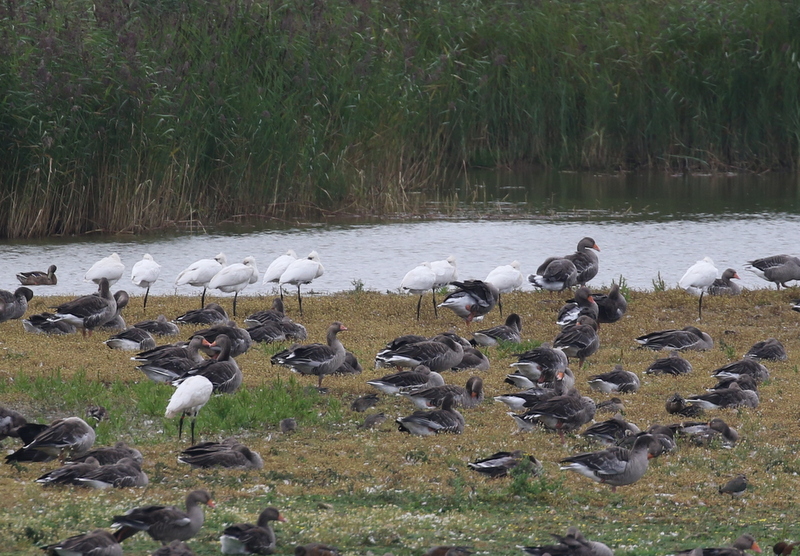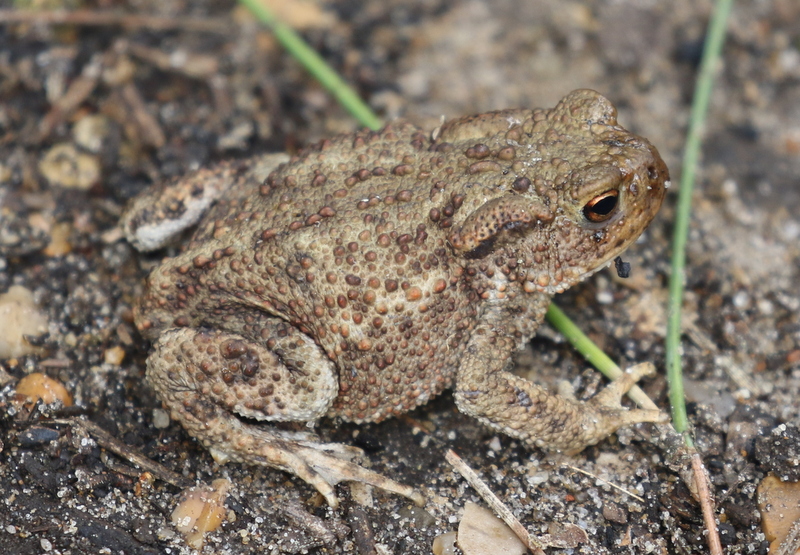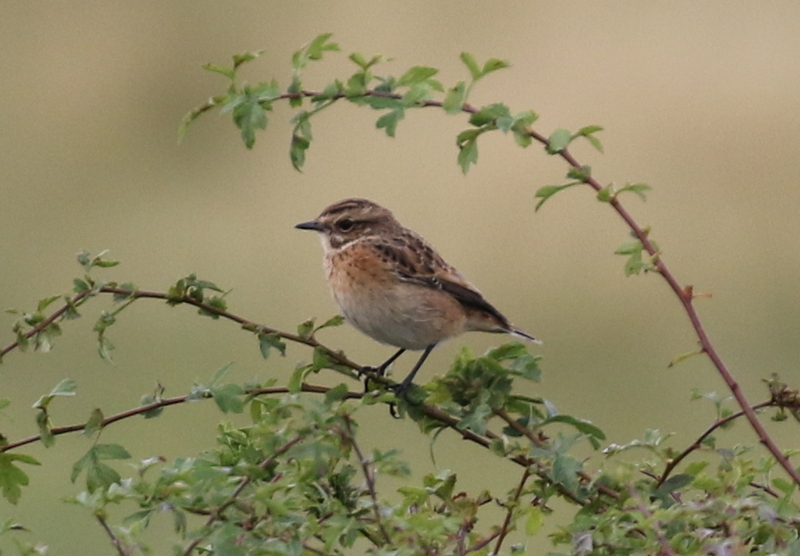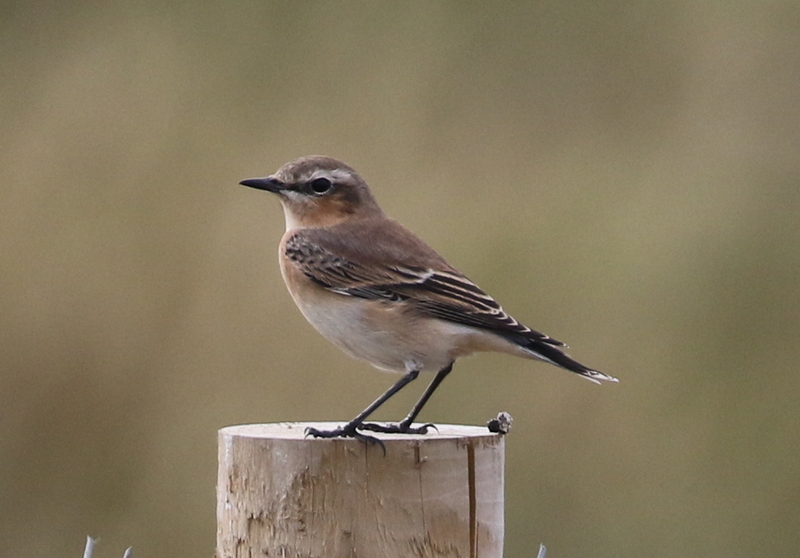Day 1 of a 3 day long weekend of tours today. It had rained overnight, but thankfully stayed mostly dry all day, even if it was rather dull and cloudy.
Our first stop was at Stiffkey Fen. As we got out of the car, a Marsh Harrier circled over the hedge across the field, as a mob of Greylag Geese and a covey of Red-legged Partridges fed in the stubble. The paths and hedges were still rather damp, and were consequently a little quiet. A Bullfinch called from the trees down by the river, but typically kept well hidden. A flock of House Martins hawked for insects over the edge of the copse – their gathering a reminder that autumn is here and they will soon be on their way south.
From up on the seawall, we had a much better view of the Fen, which is hard to see from the path now that the vegetation has all grown up. Among the throng of Greylags, we could see a line of large white birds, all asleep on one leg. They were Spoonbills, and we counted sixteen of them, most doing what Spoonbills like to do best – sleeping! One lone Spoonbill was feeding right over the back of the Fen behind one of the islands, head down, sweeping its bill from side to side through the water.
 Spoonbills – eleven of the seventeen here today
Spoonbills – eleven of the seventeen here today
Things improved Spoonbill-wise when a single bird flew in from behind us, over the saltmarsh, and dropped down into the water in the middle of the Fen. It was awake! Through the scope, we could see its spoon-shaped bill, the yellow tip showing it to be an adult. It started to preen, but two juvenile Spoonbills promptly ran out of the main group and started harassing it, bobbing their heads up and down and flapping their wings. They were its youngsters and were still trying to beg for food. The adult showed little interest in feeding them and the two juveniles quickly gave up.
There was a good selection of waders here today. The tide was still quite high over on the harbour side of the seawall, and lots of birds were roosting on the Fen. We could hear Greenshanks calling and a scan of the water as we moved round revealed at least 25 scattered around. A Green Sandpiper was feeding quietly along the edge of the reeds at the front, but a Common Sandpiper was towards the back and harder to see in the grassy edge of one of the islands. A Common Snipe was not so well camouflaged out in the open on the grass.
A large number of Black-tailed Godwits were mostly sleeping around the islands, with a few Ruff and Redshank in with them on closer inspection. We managed to find a handful of Dunlin but not the Curlew Sandpiper we had hoped to see on here (which had probably disappeared into the corner out of view). A single Avocet sweeping its bill rapidly from side to side, a couple of noisy Oystercatchers and a handful of Lapwing completed the wader list.
The ducks are not looking their best at this time of year, with the drakes in eclipse plumage, but it was still nice to see several Pintail, always a very elegant species. There are a few Wigeon already back for the winter, but most will return over the coming weeks. As well as the selection of other regular wildfowl, a couple of Bar-headed Geese looked rather more out of place, escapees from a collection somewhere.
 Greenshanks – flying out to the harbour as the tide went out
Greenshanks – flying out to the harbour as the tide went out
As the tide started to go out, the waders started to fly out to the harbour to feed. As we walked round to the edge of the saltmarsh, from where we could get a better look, a group of Greenshank flew past calling and one dropped down into the harbour channel, conveniently next to a Redshank for comparison. A call overhead alerted us to a single smaller bird with a party of Black-tailed Godwits also flying over, which was the Curlew Sandpiper heading out to the mud, though not the best of views. A steady stream of more Godwits followed, in various groups.
As the water receded, more mud was appearing out in the harbour, and there were now lots of waders out feeding on it. As well as all the Black-tailed Godwits, we managed to find a couple of Bar-tailed Godwits too. Several Curlew were walking around, probing their long bills into the mud. A careful scan added a small party of Knot, a Turnstone and we even located the Curlew Sandpiper out in the harbour – much better views than when it zipped past us earlier. However, the prize for the smartest wader went to the stunning summer plumage Grey Plover, still sporting its jet black face and belly.
Suddenly, all the waders took flight. We turned to see a Hobby shoot across the mud chasing a Dunlin. As the Dunlin turned and twisted, so the Hobby followed it close behind. When the first Hobby backed off, a second Hobby appeared and stooped at it, the two of them taking turns for a few seconds. It was exciting stuff to watch, but they seemed to lose interest quite quickly and the Dunlin managed to get away, despite being outnumbered.
 Spoonbill – flew out from the Fen to one of the saltmarsh channels
Spoonbill – flew out from the Fen to one of the saltmarsh channels
As we turned to walk back, a Kingfisher called and flew down the channel behind us in a flash of blue, before disappearing round the corner. Back up on the seawall,a couple of Common Sandpipers flew along channel and landed further up by the sluice. One flew out into the water to bathe and we got a great look at it through the scope. One of the Spoonbills took off from the Fen and flew straight towards us. It looked like it was going to drop down into the harbour channel, but a walker happened to be passing along the path just at that moment and spooked it, and the two Common Sandpipers too.
 Chiffchaff – a good number were with the tit flock
Chiffchaff – a good number were with the tit flock
When we got back to the steps, we could hear a flock of tits calling from the bushes. They made their way along the hedgerow, into a sheltered corner, where they paused to feed for a while. As well as the Long-tailed Tits, Blue and Great Tits, there were a good number of Chiffchaffs, although they were constantly on the move, flitting through the foliage or flycatching.
A much paler bird popped its head out briefly – grey crown and bright white throat. It was a very smart Lesser Whitethroat. It was hard to get onto at first, hiding in the dense hawthorns, but eventually gave itself up for us to see. As the flock moved on through, we saw several Blackcaps pass by as well. We followed the birds back along the path, flitting between the willows along the river bank ahead of us.
 Lesser Whitethroat – also with the tit flock
Lesser Whitethroat – also with the tit flock
We drove back to Holkham for lunch, and afterwards walked west from Lady Anne’s Drive on the southern edge of the pines. It was rather quiet here at first. A Goldcrest was singing half-heartedly from the top of a Holm Oak. A single Little Grebe was on Salt’s Hole, diving continually.
At Washington Hide, a juvenile Marsh Harrier appeared up from the reeds and circled round. A Kestrel and a Common Buzzard were both perched on bushes out on the grazing marshes. We walked along the boardwalk to take a quick look at the beach. We could hear another tit flock in the trees and a Treecreeper called from high in the pines above our heads. Looking out to sea, the cloud had descended again but we could hear a couple of Sandwich Terns and just see them beyond the beach.
We had a look out from Joe Jordan Hide. There were lots of Little Egrets flying in and out of the trees and several Cormorants perched up in the branches. Out on the muddy edge of the pool, we could see rather distant Green and Common Sandpipers, one of each. A Marsh Harrier circled round the wood and another landed on the grass down by the pool, the latter bearing green wing tags but too distant to read them. Further over, a Hobby kept flying out from a dead tree, hawking for insects over the marshes, before flying back to its perch, at one point attracting the unwanted attention of one of the local Jays!
There was just about enough time to carry on out to the dunes. Despite the cool and cloudy conditions, there were still some insects out. Several Migrant Hawkers and Common Darters patrolled over the vegetation by the path. A few Spotted Woods were the only butterflies of note today. Representing the amphibians, a young Common Toad hopped slowly across the path.
 Common Toad – hopped across the path
Common Toad – hopped across the path
It seemed rather quiet at first out in the dunes, exposed and cool in the breeze, apart from a few Meadow Pipits. We continued on to a more sheltered area and, as we walked up over a rise, we could see several birds on the fence ahead of us. As we watched, two Whinchats and a pair of Stonechats kept dropping down from the wires onto the ground below and back up again.
 Whinchat – here’s one in the Dunes a couple of weeks ago
Whinchat – here’s one in the Dunes a couple of weeks ago
Then a Wheatear appeared as well, flashing its white rump as it flew up onto a fencepost. When it dropped back down onto the short grass, we could see a second Wheatear too, further back.
 Wheatear – also taken on a sunnier day a couple of weeks ago!
Wheatear – also taken on a sunnier day a couple of weeks ago!
We watched the Whinchats, Stonechats and Wheatears for a while, getting great views of all three species through the scope. Eventually they started to work their way back further into the dunes. Time was getting on and we could see dark clouds gathering away to the west, so it seemed sensible to make our way back. With one last look at one of the Whinchats, perched high in a bush on the top of the dunes, we turned to go.
















